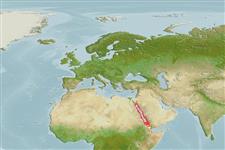>
Blenniiformes (Blennies) >
Blenniidae (Combtooth blennies) > Salariinae
Etymology: Ecsenius: Greek, exenios, -os, -on = uncontrolled, immoderate.
Eponymy: Charles Joseph Gravier (1865–1937) was a French biologist and zoologist. [...] (Ref. 128868), visit book page.
More on author: Pellegrin.
Issue
Tribe Salarinii.
Environment: milieu / Zona climática / intervalo de profundidade / distribution range
Ecologia
marinhas associadas(os) a recifes. Tropical
Western Indian Ocean: Red Sea (including the Gulf of Aqaba) to the westernmost Gulf of Aden.
Tamanho / Peso / Idade
Maturidade: Lm ? range ? - ? cm
Max length : 8.0 cm TL macho/indeterminado; (Ref. 2272)
Descrição suscinta
Chaves de identificação | Morfologia | Morfometria
Espinhos dorsais (total) : 12 - 14; Raios dorsais (total) : 16 - 19; Espinhos anais: 2; Raios anais : 18 - 21; Vértebras: 35 - 37. Dorsal fin typically XIII, 16-19 (rarely 16 or 19), spinous and segmented-ray portions with moderate notch in-between. Anal fin II,18-21 (rarely 18 or 21). Pectoral fin 13-15 (rarely 13, typically 14). Segmented caudal-fin rays 13. Vertebrae 10 or 11 (rarely 10) + 24-26 (rarely
24) = 35-37 (rarely 35). Dentary incisor teeth which includes anterior canine teeth very similar in appearance with incisors, 44-54; posterior dentary canines 0 or 1 (typically 1) on each side. Lateral line lacking pairs of pores, terminating posteriorly at a point between verticals from dorsal-fin spines 8 and 11 (rarely as far anteriorly as 8). With cirrus on posterior rim of anterior nostril; absent on anterior rim. Two color patterns: pale (northern) and dark (southern).
Body shape (shape guide): elongated; Cross section: oval.
Mimics Meiacanthus nigrolineatus (Ref. 9710). Oviparous. Eggs are demersal and adhesive (Ref. 205), and are attached to the substrate via a filamentous, adhesive pad or pedestal (Ref. 94114). Larvae are planktonic, often found in shallow, coastal waters (Ref. 94114).
Ciclo de vida ou comportamento de acasalamento
Maturidade | Reprodução | Desova | Ovos | Fecundidade | Larvas
Oviparous, distinct pairing (Ref. 205).
Springer, V.G., 1988. The Indo-Pacific blenniid fish genus Ecsenius. Smithson. Contrib. Zool. (465):134 p. (Ref. 5296)
Status na Lista Vermelha da UICN (Ref. 130435: Version 2025-1)
Ameaça para os humanos
Harmless
Uso pelos humanos
Pescarias: espécies comerciais; Aquário: Espécies comerciais
Ferramentas
Relatórios especiais
Baixar XML
Fontes da internet
Estimates based on models
Preferred temperature (Ref.
123201): 24.8 - 29.4, mean 27.2 °C (based on 134 cells).
Índice de diversidade filogenética (Ref.
82804): PD
50 = 0.5000 [Uniqueness, from 0.5 = low to 2.0 = high].
Bayesian length-weight: a=0.00776 (0.00356 - 0.01695), b=3.00 (2.81 - 3.19), in cm total length, based on LWR estimates for this (Sub)family-body shape (Ref.
93245).
Nível Trófico (Ref.
69278): 2.0 ±0.00 se; based on food items.
Resiliência (Ref.
120179): Elevada, tempo mínimo de duplicação da população menor que 15 meses (Preliminary K or Fecundity.).
Fishing Vulnerability (Ref.
59153): Low vulnerability (10 of 100).
🛈
Nutrients (Ref.
124155): Calcium = 183 [89, 322] mg/100g; Iron = 0.935 [0.530, 1.668] mg/100g; Protein = 17.8 [16.6, 18.9] %; Omega3 = 0.0864 [, ] g/100g; Selenium = 25.1 [11.6, 58.9] μg/100g; VitaminA = 113 [28, 471] μg/100g; Zinc = 2.86 [1.84, 4.20] mg/100g (wet weight);
